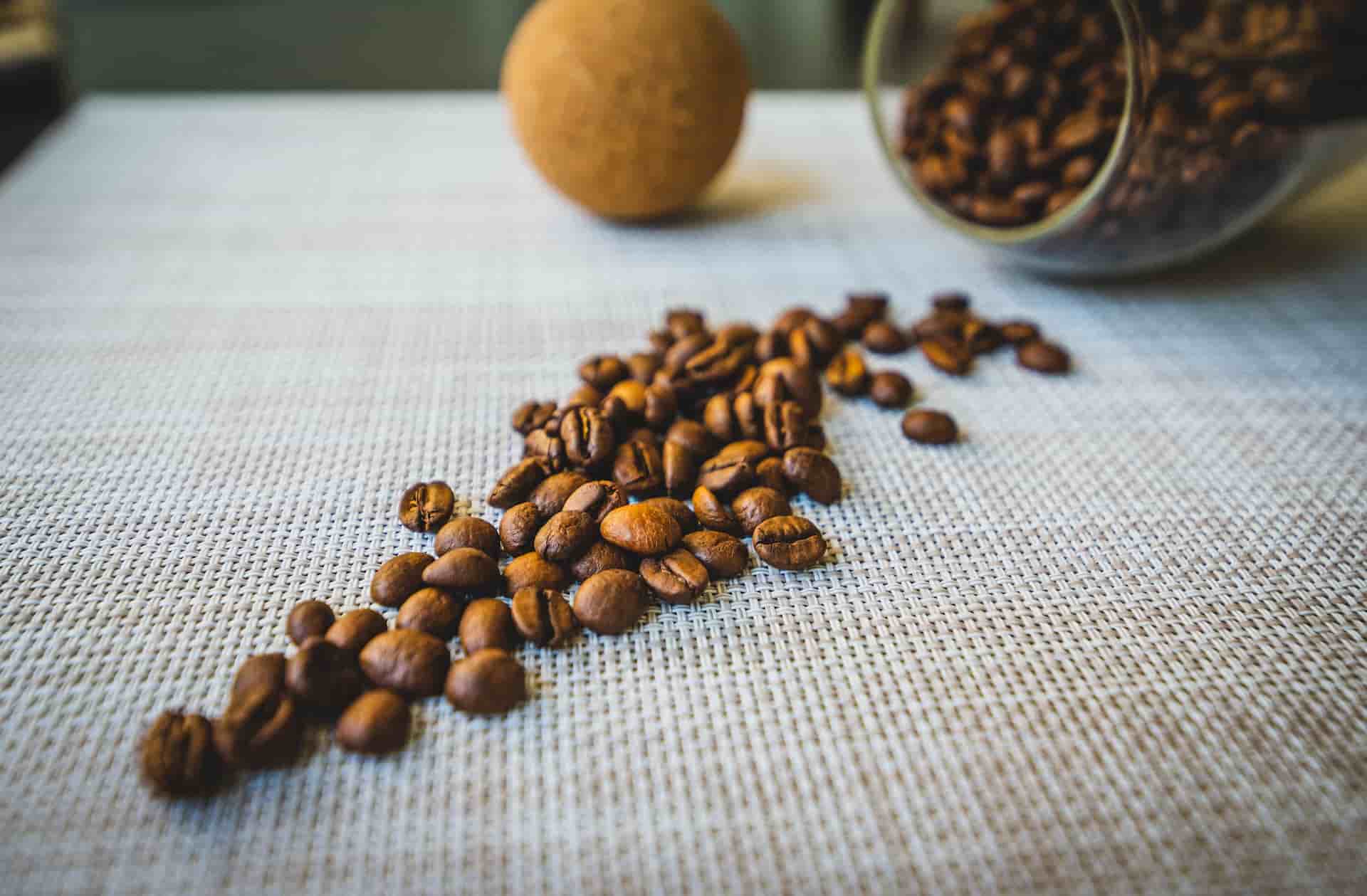Have you ever wondered if those aromatic coffee beans sitting in your coffee jar are edible?
The short answer is yes, you can indeed eat coffee beans.
Eating coffee beans is safe and offers a versatile snacking experience with potential health benefits.
However, Consuming them in moderation is key to avoiding unwanted side effects.
In this blog post, we’ll explore the various aspects of consuming coffee beans, from their taste and nutritional value to potential benefits and precautions.
So, if you’ve ever pondered about turning those beans into a snack, read on to discover more about the world of edible coffee beans.
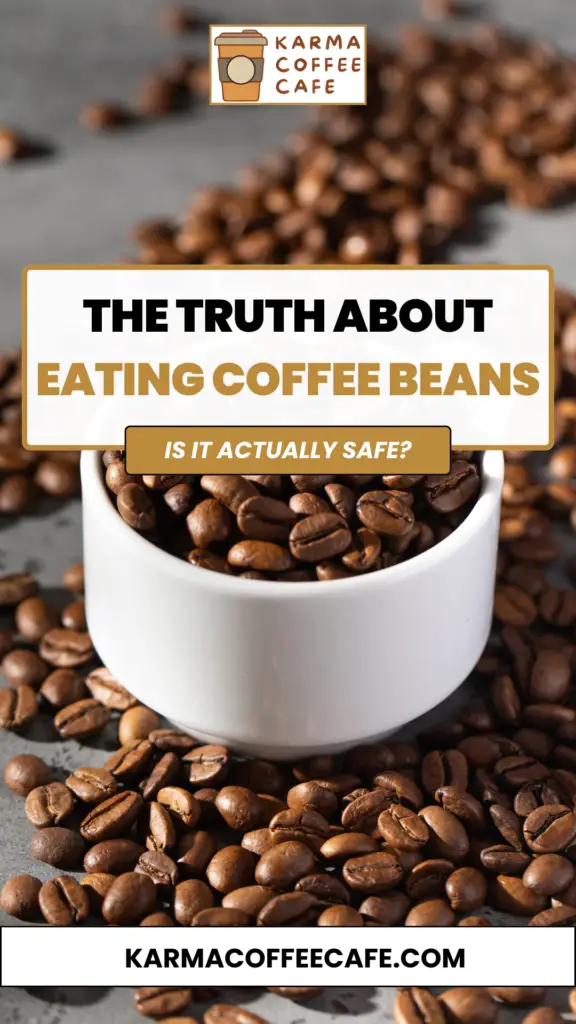
Quick Overview Of Coffee Beans
Coffee beans, the essence of our beloved beverage, are the seeds harvested from the Coffea plant.
Encased within the red or purple fruit, often called a coffee cherry, these beans, akin to the cherry’s pit, belong to the category of stone fruits.
The term “green coffee bean” refers to unroasted versions, processed to remove outer pulp and mucilage, leaving an intact wax layer.
In their immature state, these beans are vibrant green, transitioning to a brown, yellow, or reddish hue when mature.
Each dried coffee bean typically weighs between 300 to 330 mg.
With a caffeine content ranging from 1.0% to 2.5% by weight, this characteristic remains constant throughout the maturation process.
Additionally, green coffee beans house lower concentrations of theophylline, theobromine, paraxanthine, liberine, and methylliberine.
Can You Actually Eat Coffee Beans?
Certainly, indulging in coffee beans is not only safe but can also be a flavorful experience.
Brimming with antioxidants and caffeine, these beans boast potential energy-boosting properties and may even contribute to lowering the risk of specific diseases.
Nonetheless, moderation is key, given that the nutrient concentration in coffee beans surpasses that of the liquid counterpart.
If you’re looking for a tasty and convenient option, chocolate-covered, roasted coffee beans are readily available as a snack in your local store.
Is It OK To Eat Raw Coffee Beans?

Yes, consuming raw coffee beans is perfectly fine, though they come with a caveat.
Green coffee beans, in their unroasted state, are entirely edible, but brace yourself for a potentially bitter and woody flavor, coupled with a challenging texture for chewing.
While they might not win any taste contests on their own, these green beans hold their own in terms of edibility.
If you’re after a more palatable option, consider roasted coffee beans.
They are slightly softer and usually make a delightful snack, especially when coated in chocolate.
Can You Eat Coffee Grounds?

Absolutely, eating coffee grounds is entirely safe and mirrors the experience of consuming whole coffee beans.
The effects on your palate and caffeine intake remain consistent, irrespective of whether you opt for grounds or beans.
As with any coffee-related treat, moderation is key to ensure a balanced experience.
For those with sensitive teeth or a preference against the crunch of whole beans, coffee grounds offer a gentler alternative.
Their versatility extends beyond a mere snack – coffee grounds can elevate your culinary adventures.
Use them in cooking to infuse a rich coffee flavor into various dishes, or incorporate them into baked goods for a unique twist.
Additionally, coffee grounds make excellent additions to rubs for meat and vegetables, showcasing their potential beyond the confines of your coffee mug.
Benefits and Drawbacks of Eating Coffee Beans
Benefits
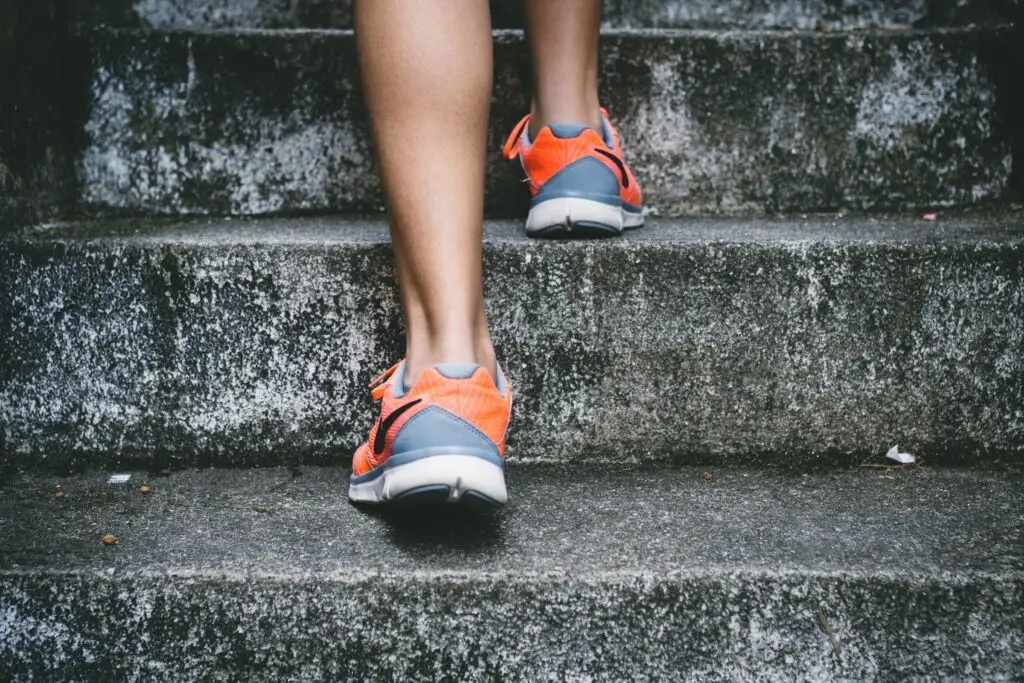
Antioxidants for Health
Coffee beans are a potent source of antioxidants, particularly chlorogenic acid.
This compound possesses anti-inflammatory properties and has shown the potential to protect the body against various diseases.
The robust antioxidant profile in coffee beans contributes to overall health and well-being, acting as a natural defense against oxidative stress.
Caffeine Boost with Added Benefits
Consuming coffee beans offers a swift and concentrated caffeine boost.
This can translate into enhanced cognitive functions, improved memory, increased stamina during physical activities, and potential support for weight loss.
The caffeine in coffee beans has been linked to heightened metabolism and increased fat burning, making it a multifaceted health contributor.
Reduced Risk of Diseases
Regular incorporation of coffee, including eating coffee beans, has been associated with a decreased risk of specific diseases.
These include liver disease, Parkinson’s disease, and certain types of cancer.
The array of bioactive compounds in coffee beans contributes to these protective effects, making them a valuable addition to a health-conscious diet.
Convenient Health Benefits
For those seeking the health benefits of coffee without the fuss of brewing a cup, eating coffee beans provides a convenient alternative.
This is particularly advantageous for individuals who desire a quick caffeine fix without the preparation time associated with traditional coffee consumption.
Drawbacks
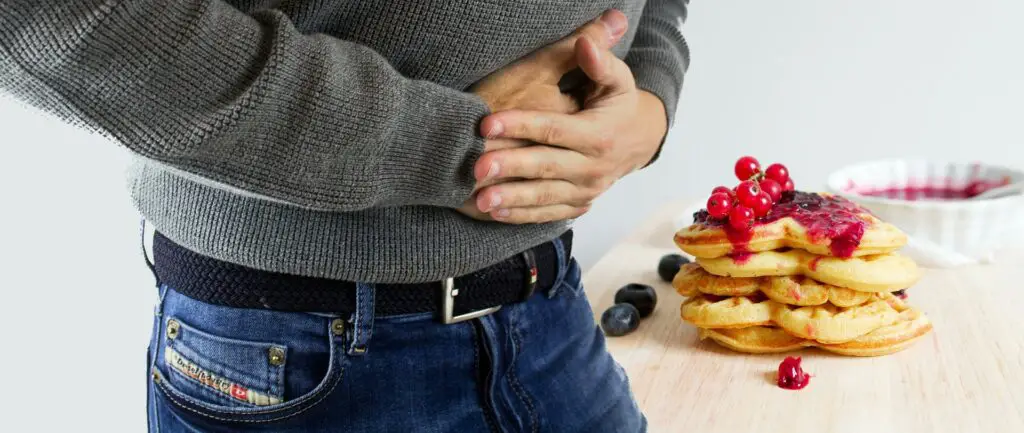
Potential Stomach Upset
While coffee beans offer various health benefits, some individuals may experience stomach upsets, heartburn, or diarrhea.
These digestive issues can arise from the compounds present in coffee beans, especially when consumed in excess.
It’s crucial to be mindful of individual tolerance levels to prevent discomfort.
Impact on Mental Health
Exceeding the recommended daily caffeine limit through the consumption of coffee beans may lead to mental health issues.
These can include heightened anxiety, restlessness, and irritability.
Monitoring caffeine intake is essential for maintaining mental well-being and avoiding potential negative effects.
Digestive Challenges
The hardness of coffee beans can pose digestive challenges, potentially causing symptoms such as bloating, gas, and stomach pain.
Additionally, the laxative effect of coffee beans, especially when consumed in large quantities, may contribute to digestive discomfort.
Moderation is key to minimizing these digestive issues.
Managing Caffeine Content
Eating coffee beans increases caffeine intake, which, when excessive, can lead to adverse effects.
These may include difficulty sleeping, nervousness, and a rapid heart rate.
Being mindful of overall caffeine consumption, including that from other sources, is crucial for maintaining a healthy balance and preventing unwanted side effects.
How Many Coffee Beans Can You Safely Eat In A Day?
The concentrated nutrients and caffeine content in coffee beans make it crucial to exercise restraint.
As mentioned earlier, consuming an excessive amount of coffee beans can lead to side effects such as heartburn, stomach upset, and the unwelcome symptoms associated with too much caffeine.
To put it in perspective, you only need to munch on 8 to 10 coffee beans to match the caffeine content in a typical cup of coffee.
However, an average chocolate-covered coffee bean carries approximately 12 mg of caffeine per bean, this also includes the caffeine in the chocolate coating.
This implies that, without surpassing the recommended safe caffeine level, adults can indulge in around 33 chocolate-covered coffee beans.
However, it’s wise to be mindful of potential downsides – these treats often come with added calories, high-fat content, and extra sugar, so moderation remains important.
Considering broader caffeine intake from various sources, including foods, beverages, or supplements, is crucial.
The FDA suggests a daily caffeine limit of 400 milligrams for healthy adults, equivalent to about four or five cups of coffee.
While this amount is generally considered safe, individual sensitivity to caffeine varies.
Therefore, it’s essential to gauge your own tolerance and moderate your coffee bean consumption accordingly to avoid any unpleasant side effects.
Which Coffee Beans Are Best To Eat?

While chocolate-covered coffee beans are a beloved choice, it’s worth noting that they often come with an added dose of sugar, calories, and fat.
However, they are typically the tastiest. We will provide a recipe for this in the next section.
For a lighter yet flavorful experience, consider indulging in lightly roasted Arabica beans.
These beans boast a mild flavor profile and pack a punch of helpful nutrients.
Another intriguing option to elevate your coffee bean snacking experience is honey-dried beans.
Not only do they offer a unique flavor, but the texture also adds an interesting dimension to the tasting adventure.
However, it’s essential to note that, in the realm of eaten coffee beans, most varieties tend to share a similar taste.
The key differentiator here is the roast level, which plays a pivotal role in determining the ultimate flavor profile.
Does Eating Coffee Beans Help With Weight Management?

Incorporating coffee beans into your diet may contribute to weight loss, thanks to the caffeine content associated with improved exercise endurance, metabolism, and increased fat burning.
To match the caffeine in a shot of espresso, you’d need to consume approximately 37 to 48 coffee beans.
While caffeine can enhance metabolic rate and fat burning in the short term, it’s worth noting that tolerance to these effects can develop over time.
For effective weight management, moderation is key, and it’s crucial to avoid adding sugar or sweeteners (yes, even chocolate) to your coffee bean snacks.
Opting for a handful of coffee beans over traditional snacks like chips, popcorn, or chocolate can be a smart move, sparing you unnecessary calories.
Coffee beans boast zero added fats, sugars, and carbohydrates, clocking in at just about 10 calories per serving.
Moreover, munching on coffee beans before a workout can be a game-changer.
Many fitness enthusiasts swear by this practice as a morning ritual, providing an extra burst of energy to kickstart their exercise routines.
It’s a fantastic way to get your heart pumping and heighten your senses, making those early-morning gym sessions or high-cardio days a little more manageable.
Chocolate-Covered Coffee Beans Recipe
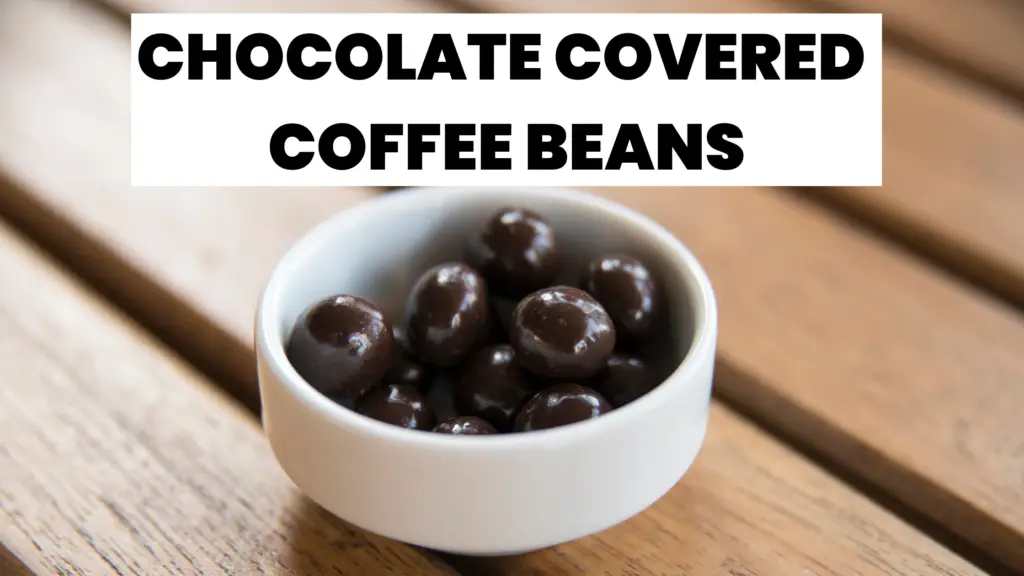
Ingredients
- 100 grams of dark chocolate
- 1/3 cup of coffee beans
Instructions
1. Prepare the Chocolate:
Finely chop the dark chocolate into small, uniform pieces.
Place the chopped chocolate in a microwave-safe bowl.
2. Melt the Chocolate:
Microwave the chocolate in 30-second intervals on low power, stirring well after each interval.
Be cautious not to overheat the chocolate to prevent burning or graininess.
3. Coat the Coffee Beans:
Once the chocolate is melted and creamy, add the coffee beans to the bowl and stir until the beans are completely coated with chocolate.
Ensure each bean is well-coated and avoid clumping.
Allow the chocolate to cool slightly to thicken before moving to the next step.
4. Set the Chocolate:
Using a fork or a dipping tool, guide the chocolate-coated coffee beans in and out of the chocolate to coat them properly.
Drain any excess chocolate by tapping the side of the bowl when raising the beans.
Transfer the evenly coated chocolate coffee beans to parchment paper in a single layer to prevent sticking.
5. Let the Chocolate Solidify:
Allow the chocolate-covered coffee beans to cool until the chocolate is solid, approximately 30 minutes.
6. Optional Toppings:
If desired, sprinkle cocoa powder, icing sugar, or crushed nuts as optional toppings on the chocolate-covered coffee beans.
7. Storage:
Once the chocolate has solidified, store the chocolate-covered coffee beans in an airtight container in a cool, dry place.
Refrigerate for easy nibbling or share as a delightful homemade edible gift.
What Are Dirty Chai Chocolate-Covered Coffee Beans?
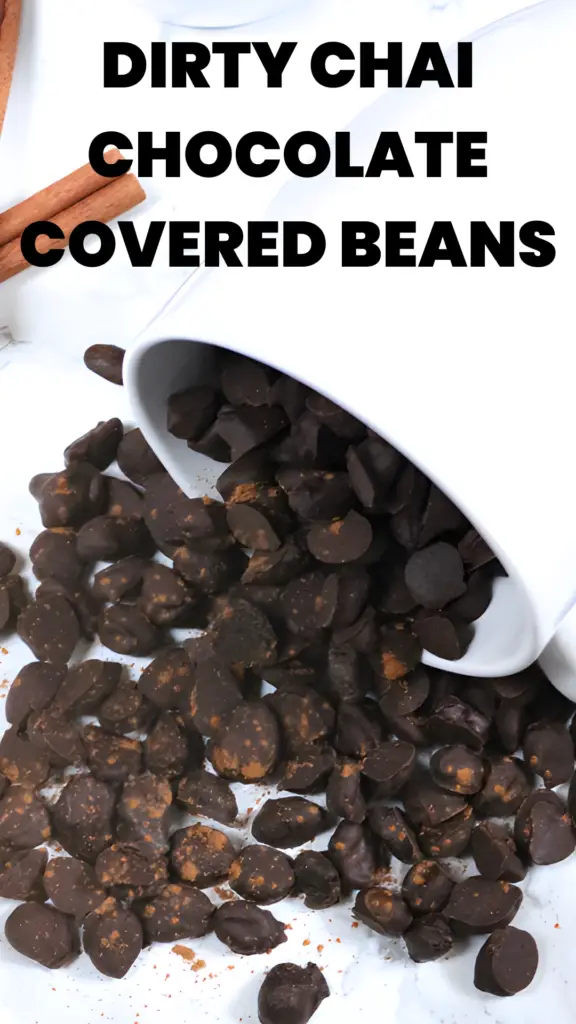
Dirty chai chocolate-covered coffee beans are coffee beans that are covered in dark chocolate flavored with chai spices such as cinnamon, ginger, cardamom, black pepper, and cloves.
These chocolate-covered coffee beans are a delicious snack and a great way to get a caffeine boost.
They are easy to make at home by melting dark chocolate and adding chai spices to it, then coating the coffee beans with the mixture and letting them dry.
Interestingly, the term “dirty chai” extends beyond these delightful beans.
In coffee shop lingo, it refers to a popular beverage that combines a shot of espresso with spiced chai tea and steamed milk.
Dirty Chai Chocolate-Covered Coffee Beans Recipe
Ingredients
- 1 2/3 cup dark chocolate chips or chopped dark chocolate
- 1 cup whole roasted coffee beans
- 1 tsp ground cinnamon
- 1/2 tsp ground ginger
- 1/4 tsp ground cardamom
- 1/4 tsp ground black pepper
- 1/4 tsp ground cloves
Instructions
1. Melt the Chocolate:
Finely chop the dark chocolate and place it in a microwave-safe bowl.
Microwave the chocolate in 30-second intervals, stirring after each interval until it is smooth and creamy.
2. Add Chai Spices:
Once the chocolate is melted, stir in the ground cinnamon, ginger, cardamom, black pepper, and cloves until well combined.
3. Coat the Coffee Beans:
Add the whole roasted coffee beans to the melted chocolate and stir until the beans are evenly coated with the chocolate mixture.
4. Arrange the Beans:
Lay out a large sheet of waxed paper or parchment paper and drop each individual bean onto the paper as neatly as possible.
Alternatively, drop a few beans at a time onto the paper to make clusters or line a large-rimmed baking sheet with the paper and evenly spread the chocolate mixture over it.
Allow the beans to dry before removing them from the waxed paper.
5. Optional: Garnish with Extra Cinnamon:
If desired, garnish the chocolate-covered coffee beans with extra cinnamon.
6. Storage:
Store the chocolate-covered coffee beans in an airtight container once they have dried.
Enjoy these delightful dirty chai-infused treats whenever you crave a unique and flavorful snack!
Conclusion
The surprising truth is that yes, you can indeed eat coffee beans.
Whether enjoyed on their own, coated in chocolate, or infused with spices, coffee beans offer a versatile and flavorful snacking experience.
From the potential health benefits, including antioxidants and a caffeine boost, to the creative culinary possibilities, the world of coffee beans extends beyond the confines of your coffee cup.
However, moderation remains key to savoring these treats without unwanted side effects.


